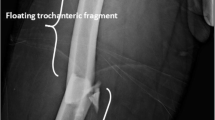Abstract
A prospective study is presented of 87 unstable intertrochanteric fractures treated with the proximal femoral nail anti-rotation (PFNA) with a follow-up of one year. Of the patients 76% were female. The average age was 75.3 years. The fracture was treated by closed reduction and intramedullary fixation. Pre-injury activity level was recovered in 77% of the patients. Fractures united in all patients. Mechanical failure and cut-out were not observed. A technical problem related to the mismatch of the proximal end of the nail was observed in 11 cases. Nine patients presented with thigh pain due to the redundant proximal end of the nail. The results of the PFNA were satisfactory in most elderly Chinese patients. However, the proximal end of the nail was not matched with the specific anatomy of some short elderly patients. Further modifications of the nail are necessary for the elderly Chinese population.



Similar content being viewed by others
References
Andreas A, Norbert S, Martin B et al (2007) Complications after intramedullary stabilization of proximal femur fractures: a retrospective analysis of 178 patients. Eur J Trauma Emerg Surg 33:262–267
Baumgaertner MR, Curtin SL, Lindskog DM et al (1995) The value of the tip-apex distance in predicting failure of fixation of peritrochanteric fractures of the hip. J Bone Joint Surg (Am) 78:1058–1064
Beatrix H, Andre G (2004) Complications following the treatment of trochanteric fractures with the gamma nail. Arch Orthop Trauma Surg 124:692–698
Brunner A, Jockel JA, Babst R (2008) The PFNA proximal femur nail in treatment of unstable proximal femur fractures—3 cases of postoperative perforation of the helical blade into the hip joint. J Orthop Trauma 22:731–736
Domingo L, Cecilia D, Herrera A et al (2001) Trochanteric fractures treated with a proximal femoral nail. Int Orthop 25:298–301
Evans PJ, Mcgory BJ (2002) Fractures of the proximal femur. Hospital Physician 38(4):30–38
Felix B, Henry Z, Christoph L et al (2005) Treatment strategies for proximal femur fractures in osteoporotic patients. Osteoporos Int 16:S93–S102
Jin HH, Jong KO, Sang HH et al (2008) Mismatch between PFNa and medullary canal causing difficulty in nailing of the pertrochanteric fractures. Arch Orthop Trauma Surg 128(12):1443–1446
Keats AS (1978) ASA classification of physical status: a recapitulation. Anesthesiology 49:233–236
Lenich A, May E, Rüter A et al (2006) First results with the trochanter fixation nail (TFN): a report on 120 cases. Arch Orthop Trauma Surg 126:706–712
Leung KS, Procter P, Robioneck B et al (1996) Geometric mismatch of the Gamma nail to the Chinese femur. Clin Orthop Relat Res 323:42–48
Müller ME, Nazarian S, Koch P, Schatzker J (1990) The comprehensive classification of fractures of long bones. Springer, Berlin
Papasimos S, Koutsojannis CM, Panagopoulos A (2005) A randomised comparison of AMBI, TGN and PFN for treatment of unstable trochanteric fractures. Arch Orthop Trauma Surg 125:462–468
Schipper IB, Steyerberg EW, Castelein RM et al (2004) Treatment of unstable trochanteric fractures: Randomised comparison of the gamma nail and the proximal femoral nail. J Bone Joint Surg (Br) 86:86–94
Simmermacher RKJ, Bosch AM, Van Der Werken C (1999) The AO/ASIF proximal femoral nail (PFN): a new device for the treatment of unstable proximal fractures. Injury 30:327–332
Simmermacher RKJ, Ljungqvist J, Bail H et al (2008) The new proximal femoral nail antirotation (PFNA) in daily practice: results of a multicentre clinical study. Injury 39:932–939
Statement on conflict of interest
The authors have not received nor will receive benefits from any source for this study.
Author information
Authors and Affiliations
Corresponding author
Rights and permissions
About this article
Cite this article
Pu, JS., Liu, L., Wang, GL. et al. Results of the proximal femoral nail anti-rotation (PFNA) in elderly Chinese patients. International Orthopaedics (SICOT) 33, 1441–1444 (2009). https://doi.org/10.1007/s00264-009-0776-3
Received:
Accepted:
Published:
Issue Date:
DOI: https://doi.org/10.1007/s00264-009-0776-3




